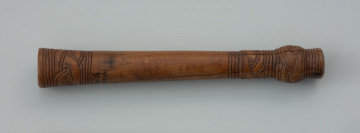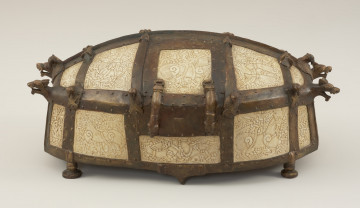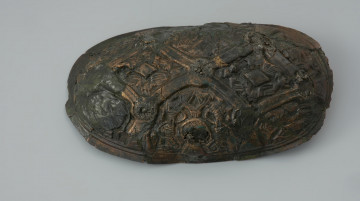
Wooden frame
840 — 980
National Museum in Szczecin
Part of the collection: Middle Ages
The wooden handle preserved with the iron knife has a decoration characteristic for the Scandinavian culture. Mutual Pomeranian-Scandinavian contacts in the early Middle Ages, examined from the point of view of political, economic and cultural connections, have for years aroused the unflagging interest of historians and archaeologists. Contacts between the peoples of the North and the Slavs on the southern coast of the Baltic Sea are reflected, among other things, in the presence of products of Scandinavian origin, including standard and luxury items and raw materials necessary for critical sectors of craft production, such as low-phosphorus iron and phyllite. In almost all periods of history, the Baltic Sea has been more a bridge than a barrier to contact between the northern and southern coastal zones. The numerous bays, coves and lagoons were significant, which were successfully used as natural harbours for low draught boats and ships from prehistory until the end of the 10th century. Concrete evidence of Slavic-Scandinavian interaction on the southern Baltic coast in the 8th-11th centuries includes 15 now known artisanal and trading settlements between the Limes Saxoniae in the west and the Vistula estuary in the east. Some were abandoned in the Middle Ages, such as Groß Strömkendorf, Rostock-Dierkow, Menzlin, Bardy/Świelubie and Janów Pomorski. Others, such as Ralswiek, Wolin, Szczecin, Kolobrzeg functioned and developed further. Crafts such as basalt grindstones, glass beads and vessels, foreign pottery, phyllite whetstones, soapstone vessels, scales and weights come from those sites indicating that these settlements were links in a trade network spanning coastal zones across Europe. Costume ornaments, pins, fibulae, brooches, and weapons, originate in many cases from Scandinavia and can be examples of intense direct and cultural exchange between Scandinavia and the southern Baltic Region.
Anna Bogumiła Kowalska
Author / creator
Dimensions
cały obiekt: height: 17.2 cm, width: 1.9 cm
Object type
haus furnishing, knife
Technique
sculpture, planing, forging
Material
wood, iron
Origin / acquisition method
legal transfer
Creation time / dating
Creation / finding place
Owner
Muzeum Narodowe w Szczecinie
Identification number
Location / status

840 — 980
National Museum in Szczecin

951 — 1050
National Museum in Szczecin

840 — 980
National Museum in Szczecin
DISCOVER this TOPIC
National Museum in Lublin
DISCOVER this PATH
Educational path